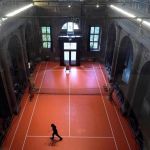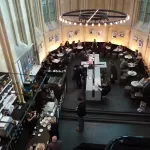
The new life of deconsecrated churches
Fashion, clubbing, dining, culture but also housing: genesis of a new real estate trend
January 26th, 2023
Murals, marble, naves, precious bas-reliefs, Tuscan columns, masterpieces of art: churches hold an almost uncanny fascination for us, perhaps the legacy of a childhood spent amidst the exhalations of incense and the preoccupation of 'dressing well' for Sunday Mass. Yet the same places that frightened us as children now exert an unexpected charm that is not necessarily gloomy or gothic, but certainly dissolute and attractive. And it is precisely on this paradoxical sense of dissolution that entrepreneurs around the world have based the success of discos, bars, and hotels. Not least Soho House Stockholm, the second club to open its doors in Scandinavia, is an exclusive new club in a deconsecrated Methodist church with 1,430 square meters of space, high vaulted ceilings dating back to 1894, stained glass windows, original columns and painted details on the stone walls. Fashion, clubbing, dining, culture, but also living: everything you can do in an ordinary secular building takes on a whole new appeal in a deconsecrated church. And if in Great Britain 50,000 churches have been converted into shops, restaurants, and offices, Italy is in no way inferior and is the protagonist of a trend investigated by the portal immobiliare.it.
In Milan in particular, there are numerous sacred places used in profane contexts: from the deconsecrated church of San Giuseppe alla Pace, which houses the archaic Café Gattopardo, where a huge chandelier with some 65,000 crystals reigns supreme, to La Chiesetta in Chinatown and Café Trefor in San Donato Milanese, to San Carpoforo in Via Formentini, which is now a classroom of the Academy of Fine Arts. The Baroque church of San Paolo Converso deserves a mention, once a sought-after concert hall and recording studio thanks to its excellent acoustics, and now an exhibition space for contemporary art. Among the most curious performances that have taken place, there is the 2017 work by Asad Raza, who wanted to recreate a kind of tennis match between the naves of the church, complete with a court, rackets, and balls. Via della Moscova, on the other hand, is home to the remains of a 17th-century Carmelite convent, the Baroque church of Saints Teresa and Joseph, now known as the Mediateca di Santa Teresa, which after years of neglect has become a huge 'library without books'. Abroad, the trend is no less strong: in Utrecht, Holland, a late 19th-century church has been transformed into a sophisticated 500-square-meter flat by Zecc Architects. Club Paradiso on Leidseplein in the heart of Amsterdam, one of the most popular venues on the rock scene in northern Europe, was founded in 1965 within the walls of a sacred place that has to date hosted international artists of the caliber of David Bowie, Guns N' Roses, Nirvana and the Sex Pistols, while The Church Nightclub in Denver, Colorado, is housed in a Gothic-style building with very high ceilings, huge windows and an excellent sound system, a mecca for top international DJs. Not to mention the Book Store Dominicanen, a former parish church converted into an independent bookshop in the center of Maastricht, or The Church Bar in Dublin, a typical pub offering traditional dancing and live music. The fashion system, on the other hand, prefers fully sacred venues that are still active today, such as Christ Church Spitalfields, which was the setting for Alexander McQueen's Dante collection, where models wore masks adorned with crucifixes and brocades, or Westminster Abbey, chosen by Gucci for its Cruise collection in 2017 and by Vivienne Westwood two years later.
Today, deconsecrated churches fill the ads of real estate agencies, mainly due to a decline in the number of believers that leads parishes to review the number and location of their places of worship on the territory, as in the case of Australia, where a census revealed that the percentage of Christians has dropped below 50% for the first time, while the New York Times reveals that from 2013 to 2018 more than three dozen buildings of worship in Manhattan were razed or redeveloped. According to Immobiliare.it, even in Italy, a large number of deconsecrated churches are about to be sold for residential use, as in the case of the small church in Lucca that will be transformed into a two-story home with a swimming pool. In Florence, in the Careggi area, a 170 square meter church can be purchased for €780,000, while Olevano sul Tusciano is offering a 14th-century parish for €90,000. In Volterra, a church dating back to 850 DC has been put up for sale at a cost of €1,650,000, in Cortina, a monastery with a bell tower and two ruins are available for €550,000. Because, after all, who would not want to live in a deconsecrated church?





































.jpg)





























